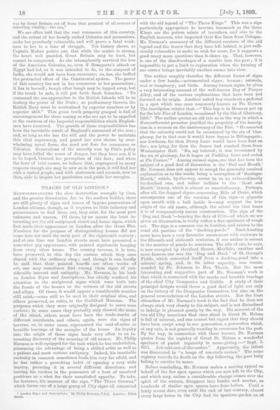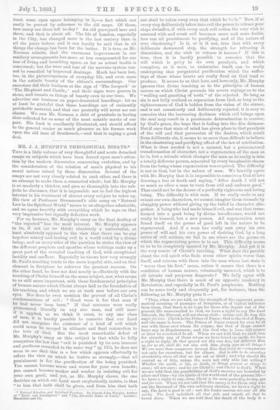TRACES OF OLD LONDON.* NOTWITHSTANDING the slow destruction wrought by
time, and the greater devastation due to the modern builder, there are still plenty of signs and traces of bygone generations of London citizens, though, as it requires no little industry and perseverance to find them out, they exist for the most part unknown and unseen. Of these, by no means the least in- teresting are the old sculptured street and house signs, which first made their appearance in London after the Great Fire. Numbers for the purpose of distinguishing houses did not come into use until the early part of the eighteenth century ; and at one time our London streets must have presented a somewhat gay appearance, with painted eignboards hanging from every other house. The country taverns, it is true, have preserved to this day the custom which they once shared with the ordinary shop ; and though it can hardly be said that their painted board's are often works of art, one may sometimes find among them signs of con- siderable interest and antiquity. Mr. Norman, in his book on London Signs and Inscriptions, has chiefly confined his attention to the sculptured signs which were built into the fronts of the houses or the corners of the old streets and alleys. Of these, it would appear a considerable number still exist,—some still to be seen in their original sites, and others preserved, as relics, in the Guildhall Museum. The purposes which they were originally designed to serve were various ; in some cases they probably only showed the name of the street, others must have been the trade-marks of different merchants, and others, again, were the signs of taverns, or, in some cases, represented the coat-of-arms or heraldic bearings of the occupier of the house. An inquiry into the origin of these signs leads very often to an in. teresting discovery of the meaning of old names. Mr. Philip Norman is well equipped for the task which he has undertaken, possessing the advantage of being a skilled artist as well as a patient and most curious antiquary. Indeed, his insatiable curiosity in research sometimes leads him very far afield, and he has rather a provoking habit of opening a very wide inquiry, pursuing it in several different directions, and leaving his readers in the possession of a host of unsolved problems as a whet for their unsatisfied appetite. To take, for instance, his account of the sign, "The Three Crowns," which forms one of a large group of City signs all connected * London Siring and Inscriptions, By rhilip Norman, F.S.A. London Elliot Stook. with the old legend of "The Three Kings." This was a sign particularly appropriate to taverns, inasmuch as the three Kings are the patron saints of travellers, and also to the English mercers, who imported their fine linen from Cologne. Mr. Norman's summary of the different versions of the old legend and the traces that they have left behind, is just suffi- ciently exhaustive to make us wish for more, for it suggests a good many more questions than it clears up. That, however, is one of the disadvantages of a ramble into the post; it is impossible to put a limit to exploration when the turning of one corner brings inevitably another corner into view.
The author roughly classifies the different forms of signs under a few heads,—astronomical signs ; human ; animals, real or imaginary; and birds. Among human signs, he gives a very interesting account of the well-known Boy of Panyer Alley, and of the various explanations that have been put forward as its origin. Another naked boy stands on a pedestal in a spot which was once commonly known as Pie Corner. The inscription relates that,—" This boy is in Memory put up for the late Fire of London, occasioned by the Sin of Gluttony, 1666." The author quotes an old tale as to the way in which a Nonconformist preacher justified the propriety of the inscrip- tion in a sermon on the anniversary of the Fire. "He asserted that the calamity could not be occasioned by the sin of blas- phemy, for in that case it would have begun in Billingsgate ; nor lewdness, for then Drury Lane would have been first on fire ; nor lying, for then the flames had reached them from Westminster Hall. No, my beloved; it was occasioned by the sin of gluttony, for it began at Pudding Lane and ended at Pie Corner." Among animal signs, one that has been the subject of a good deal of discussion is the Bull and Mouth.' Mr. Norman does not appear to accept the generally received explanation as to the words being a corruption of Boulogne Mouth,' which, by-the-way, seems to us an extraordinarily far-fetched one, and rather inclines to the Bowl and Month' theory, which is almost as unsatisfactory. Perhaps, after all, the doggrel rhyme concerning Milo of Crete, which accompanies one of the versions of this sign—a gigantic open mouth with a bull inside it—may suggest the true origin of the old name, although the actual inn that bears it is of comparatively recent construction. The sign of the Dog and Duck '—bearing the date of 1716—of which we are given an illustration, is really rather a fine specimen of rough art. The sign is a common one in London, and relates to the cruel old pastime of the "ducking-ponds." Duck-hunting must have been a very favourite amusement with cockneys in the fifteenth and sixteenth centuries, if our author is correct in the number of ponds he mentions. The site of one, he says, is now occupied by Hertford Street, Mayfair ; another and more famous one was the Dog and Duck' of St. George's Fields, which converted itself from a ducking-pond into a mineral spring, and, in its latter capacity, was recom- mended by Dr. Johnson to Mrs. Thrale. But the most interesting and suggestive part of Mr. Norman's work is that which is connected with the marks and heraldic bearings of the chief City Companies and Guilds. A study of their principal designs would throw a good deal of light not only on the history of the Companies themselves, but also on the general nomenclature of the London streets. Not the least attraction of Mr. Norman's book is the fact that he does not always stick very closely to his subject, and is not disinclined to indulge in pleasant gossip by the way. His account of the two old City mansions that once stood in Great St. Helens is full of interest, and one cannot but regret that they should have been swept away in our generation, a generation which, at any rate, is not generally wanting in reverence for the past. By the way, in connection with these houses, Dr. Norman quotes from the registry of Great St. Helens a wonderful specimen of parish ingenuity in name-giving :—" Sept. 1, 1611. Job-ra,kt-out-of-the-asshes." Apparently, the infant was discovered in "a heape of sea-coale wishes." The same registry records its death on the day following, the poor baby failing to survive its name.
Before concluding, Mr. Norman makes a moving appeal on behalf of the few open spaces which are now left in the City, and which may, unless a considerable change comes over the spirit of the owners, disappear into bricks and mortar, as hundreds of similar open spaces have done before. Until a fairly recent date, even until the end of last century, almost every large house in the City had its spacious garden or, at
least, some open apace belonging to it,—a fact which can easily be proved by referenee to the old maps. Of these, how many are there left to-day ? An old graveyard here and there, and that is about all. The life of London, especially in the City, .has changed more in the last century than in all the years before, and it can hardly be said that in all things the change has been for the better. It is true, as Mr. Norman admits, that the enormous improvement in our sanitary arrangements has more or less compensated for our loss of living and breathing space, as far as actual health is concerned; but the wear and tear of the nervous system can- not be remedied by improved drainage. Much has been lost, too, in the picturesqueness of everyday life, and even more in the artistic beauty of the citizen's surroundings. Our ancestors did their business at the sign of The Leopard' or The Elephant and Castle ; ' and their signs were graven in stone, and remain as things of beauty even to our time. We advertise our business on paper-decorated hoardings : let us at least be grateful that these hoardings are of eminently perishable material, and that our posterity will never see our shame. We owe Mr. Norman a debt of gratitude in having thus collected for us some of the most notable marks of our past. His book is excellently illustrated, and should afford to the general reader as much pleasure as his former work upon the old inns of Southwark,—an.d that is saying a good deal,











































 Previous page
Previous page